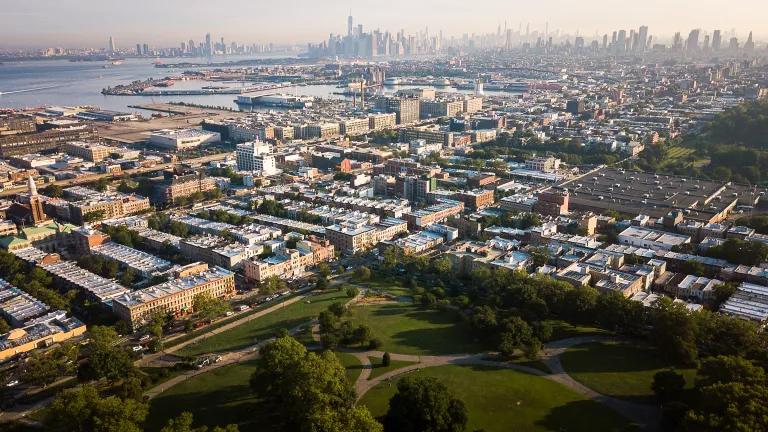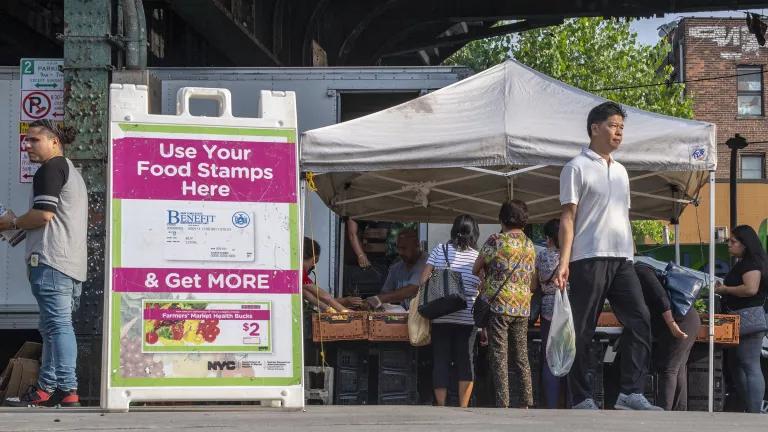New Yorkers Have Constitutionally Protected Environmental Rights!
Now We Need State Government, Agencies, and Officials to Recognize and Protect Them

Green Amendment Rally, Albany New York
Photo credit: Green Amendments For The Generations
This post was coauthored with Steven Villegas, NRDC Litigation Intern, Summer 2024.
On July 12th, Albany buzzed with the energy of environmental justice as advocates gathered at the Capitol for the NY Green Amendment Rally and March for Environmental Rights. The rally underscored New Yorkers’ desire for government officials to prioritize the newly enshrined right to clean air, water, and a healthy environment. This right, also referred to as the green amendment, was a milestone years in the making, requiring passage as legislation in two consecutive legislative sessions before being advanced to a ballot referendum in 2021. The overwhelming majority of New Yorkers (more than 70%) voted for its inclusion in the state’s constitution. New York is one of only three states to have such a constitutional right.

Environmental Rights Advocates in front of New York State Capitol
Photo credit: Green Amendments For The Generations

Merton D. Simpson, Albany County Legislative District 2, Maya van Rossum, Founder of the Green Amendment For The Generations Movement, and Senator Robert Jackson marching along with advocates
Photo credit: Green Amendments For The Generations
Since its adoption in 2021, it has been largely unknown how the right will be recognized by government decision-makers, how it will be considered by courts, and how it will ultimately impact the environmental regulatory framework in the state. What is certain and historic is this: its placement in Article 1 of the State Constitution makes it an inalienable right that cannot be ignored or infringed upon.
The advocacy for a Green Amendment was born out of the water contamination crisis of Hoosick Falls, NY. The crisis in Hoosick Falls demonstrated a clear instance where existing environmental laws failed to adequately protect the community against then-unregulated chemicals. In 2016, residents discovered their water was contaminated with toxic perfluorooctanoic acid (PFOA), which is just one out of thousands of chemicals in the per- and polyfluoroalkyl substances (PFAS) class linked to cancers, hormone disruption and liver dysfunction to birth defects, and infertility. PFAS are used in products like firefighting foam and nonstick cookware, and in the case of Hoosick falls emanated from a manufacturing site (now a federal Superfund site) that left the public drinking water supply and private wells highly polluted.

Once rated the best-tasting water in the state of New York, the groundwater that supplies the village of Hoosick Falls with drinking water is heavily contaminated with perfluorooctanoic acid (PFOA).
Photo credit: https://inthesetimes.com/article/industrial-pollution-pfoa-drinking-water-contamination-epa-saint-gobain
And it’s not just Hoosick Falls, communities across the state have been impacted by these “forever chemicals” (aptly coined because of their persistence in the environment and in our bodies). In particular, low-income communities and Black and Latinx communities continue to bear disproportionately high health burdens from environmental pollution, despite the presence of robust environmental laws and regulations. Examples of these environmental injustices can be seen in Mount Vernon, Brookhaven, and Buffalo. The Green Amendment is recognized as an important tool to fill this gap and prevent potentially-vulnerable areas from taking the brunt of adverse environmental impacts.
Communities test its power
Communities have started to test the power of the Green Amendment, bringing claims challenging government action (or inaction). One such case is Fresh Air for the Eastside (FAFE) vs. State. The FAFE case involves residents near the High Acres Landfill who have long suffered from its noxious air emissions. FAFE, a community organization, represents residents fighting the adverse effects of the landfill's operations. They are using the Green Amendment to demand better environmental practices, stating in their complaint that “[t]he constitutional rights of its members to clean air and a healthy environment... are being violated as a result of the actions or inactions on the part of the Defendants regarding the High Acres Landfill.” Beginning in mid-2015, New York City started shipping municipal solid waste by rail to High Acres increasing the total amount of garbage accepted by the landfill by more than 250%. In 2020, almost 650,000 tons of solid waste were shipped from New York City via rail to this 300-acre landfill. New York City’s garbage now represents about 90% of all solid waste disposed at the Landfill.

High Acres Landfill, Perinton, NY
Photo credit: Max Schulte/ @Maxrocphoto (X) @Schultephoto (Instagram)
The legal battle began when FAFE filed a lawsuit against Waste Management of New York, LLC; the New York State Department of Environmental Conservation (NYSDEC); the City of New York; and the State of New York, alleging that the High Acres landfill's emissions are causing significant health and environmental problems. The case has progressed through several stages, including a notable state trial court decision, in which the court ruled in favor of FAFE in response to the defendant’s motion to dismiss, allowing the case to proceed. Judge Ark stated, “These lawsuits set forth the apparent failings of the existing regulatory processes and seek added redress through the Green Amendment. Whether the Green Amendment will be an important tool to allow communities to safeguard their environment and compel state and local governments to act to prevent environmental harms is uncertain.”
This decision was a qualified victory for FAFE, as it enabled the lawsuit to move forward but also highlighted challenges in enforcing the Green Amendment. The State's position in the FAFE case demonstrates a concerning reluctance to recognize the importance and new duty-creating nature of the Green Amendment. The State argues that existing regulations are sufficient and that the Green Amendment does not impose new obligations on the State to act against third parties like Waste Management. In their arguments, the State asserts that the Green Amendment does not override its enforcement discretion, but that while it establishes a constitutional right, it does not require the state to act against third parties. The State's argument fails to acknowledge that NYSDEC takes plenty of state actions when permitting and enforcing against third parties, like Waste Management. Judge Ark comments on the State's posturing, stating “Indeed, the vigor of the State's opposition to this lawsuit does not bode well for its enforcement of the Green Amendment.”
During oral arguments held on May 20, 2024, before the State’s intermediate appeals court, the State continued its line of argument that the Green Amendment should not override existing regulations or alter their enforcement discretion. They asserted that judicial enforcement would overstep into policymaking and that the amendment requires additional legislative framework for proper implementation. Conversely, FAFE argued that the Green Amendment is self-executing and empowers the public to demand more robust administrative actions from the State environmental agency, emphasizing that it is a fundamental right intended to exceed existing laws. On the issue of self-execution, Judge Ark quoted and agreed with the following analysis provided in an Albany Law School Government Law Center explainer entitled, New York’s New Constitutional Environmental Bill of Rights: Impact and Implications:
"the general rule is that constitutional provisions are presumptively self-executing. In contrast to the constitutional provisions referenced above, which explicitly reference further action by the legislature, there is no mention in the text of the Green Amendment of involvement of the legislature or legislative process as a predicate to implementation. Consequently, based on the plain text, it would seem that the Green Amendment is enforceable without additional legislation.”
As courts and government agencies continue to interpret and apply the Green Amendment, arguments like the ones advanced by the State in FAFE risk undermining the efficacy of the Green Amendment. A robust judicial interpretation is crucial for setting future precedents and will ultimately determine whether the Green Amendment is merely a vestigial structure in the State constitution, or an important tool capable of compelling the State to address environmental harms.
Strong advocacy from all generations is critical
The rally in Albany, featuring passionate speeches from community leaders and activists of all ages, provided the necessary counterbalance in emphasizing the need for state governments and agencies to fully embrace the Green Amendment and ensure they are not making decisions that would infringe on these new constitutional rights. Attendees gathered on the steps of the State capitol, chanting, singing, and listening to speakers. They then marched throughout Albany to deliver a letter to the Governor, the Attorney General, and Acting NYDEC Commissioner, urging them to fully embrace the rights, duties, and obligations created by Green Amendment and expressing concern over the state's current defensive posture in recent litigation.

Children delivering Green Amendment poster and advocate letter to DEC representative
Photo credit: Green Amendments For The Generations
As we saw displayed at the rally, the Green Amendment's clear language empowers advocacy groups to push for more rigorous enforcement actions and policy revisions, ensuring that the right to a healthful environment is upheld.
The FAFE case and the Rally serve as reminders that while constitutional protections are a significant victory, they are only the beginning. We need active engagement from state governments, agencies, and officials to recognize and enforce these rights. The rally was not just a demonstration but a call for action, urging everyone to work together to ensure that the vision of a New York with guaranteed environmental rights becomes a lasting reality.
For more updates and ways to get involved, keep an eye on the NRDC website. Together, we can ensure a cleaner, healthier future for all New Yorkers.

.jpg.jpg?h=44b879e5&itok=Mrg2EnX5)

